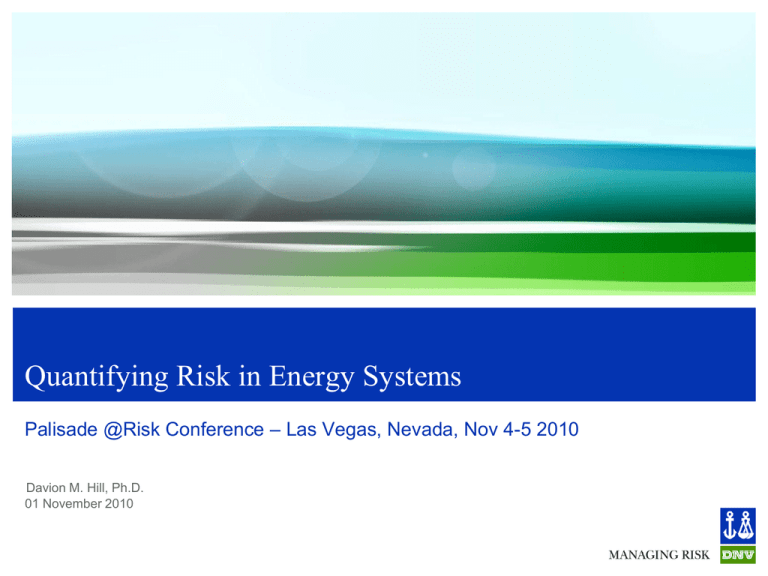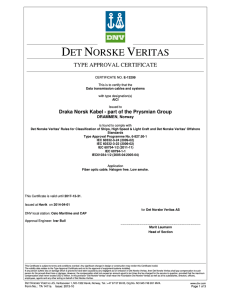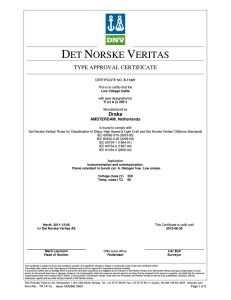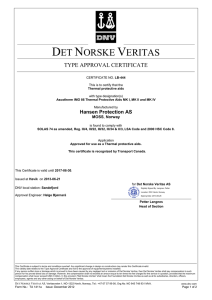
Quantifying Risk in Energy Systems
Palisade @Risk Conference – Las Vegas, Nevada, Nov 4-5 2010
Davion M. Hill, Ph.D.
01 November 2010
What does DNV do?
DNV was founded in 1864 to fill a need for an objective
third party to assess sailing ships for their seaworthiness
- In the19th century, sailing and shipping was risky
business, but with great rewards possible
- Ship builders needed an objective reviewer to prove
their worth to buyers and insurers
Milestones
- 1951: Internal Research
- 1969: Oil in the North Sea
- 2004: Offshore Wind
3rd party role
Advisory role
Buyer
Energy System Output, Reliability, and ROI Projections
01 November 2010
© Det Norske Veritas AS. All rights reserved.
2
Seller
Predictions
Don’t cross a river if it is four feet deep on
average.
Energy System Output, Reliability, and ROI Projections
01 November 2010
© Det Norske Veritas AS. All rights reserved.
3
Risk in Energy Systems
Prices and Sale of Products Converted from CO2
$1,400
45000
Energy-Price
Gap favorable
40000
Energy-Price
Gap too high
35000
$1,000
$ per metric ton
30000
$800
25000
20000
$600
15000
$400
10000
$200
5000
$0
0
HCOOH
CO
Methanol
Ethylene
Methane
Product
Market Price $/ton
Wind
Solar
Oil & Gas
Energy System Output, Reliability, and ROI Projections
01 November 2010
© Det Norske Veritas AS. All rights reserved.
4
Nuclear
Invested kWh/ton
CO2
Recycling
Invested Energy in Creation of Product (kWh/ton)
$1,200
WIND AND SOLAR
Energy System Output, Reliability, and ROI Projections
01 November 2010
© Det Norske Veritas AS. All rights reserved.
5
Two Case Studies: US Wind Turbine Fleet and 1 MW Solar Farm
Case 1: Wind Fleet
Case 2: Solar Farm
Inputs
Inputs
Capacity Factor
Efficiency of
Panel
Sale price of electricity
Cost of
electricity
Electrical
Subsystem
Failure Rates
Blade Failure Rates
Gearbox Failure Rates
First Level
Outputs
Output of
fleet per year
(MWh/year)
Earnings of
fleet per year
($/year)
What effect
would
reliability
have on
meeting the
20% Wind by
2030 goal?
Energy System Output, Reliability, and ROI Projections
01 November 2010
© Det Norske Veritas AS. All rights reserved.
First Level
Outputs
Risk
Metrics
Energy: Total
Output
(MWh/year)
CO2:
Total
Offset Emissions
(ton/year) based
on MWh output
(includes
avoided and life
cycle emissions)
Dollars: Product
of Total Output
and
cost
of
electricity
($/year)
Output per
panel per day
(kWh/day)
ROI
Outputs
Earnings per
panel per day
($/day)
Energy: Total
Output
(kWh/day)
How much
does panel
efficiency
degradation
matter for
large scale
solar farms?
“Probabilistic Energy ROI Models: Carbon, Energy, and Dollars”. ASME Energy Sustainability, 2010.
#90408 Phoenix, AZ.
6
CO2: Total Offset
Emissions (ton/day)
based on kWh output
(includes avoided
and life cycle
emissions)
Dollars: Product of
Total Output and
cost of electricity
($/day)
Life Cycle Estimates Including Materials Failure: Wind Turbines
Production of hypothetical US wind fleet between
present and 2030, including blade, gearbox, and
electronics failures (first generation turbines).
Best case scenario with
minimal failures, improved
capacity factor.
Least favorable scenario
with compounded failures
and poor capacity factor.
Energy System Output, Reliability, and ROI Projections
01 November 2010
© Det Norske Veritas AS. All rights reserved.
7
Capacity Factor dominates
Energy System Output, Reliability, and ROI Projections
01 November 2010
© Det Norske Veritas AS. All rights reserved.
8
Sensitivity to Return on Investment
Impact on ROI is more visible from failures, but revenue per kWh produced
and capacity factor are again dominant.
ROI Parameter
Energy ROI
CO2 ROI
Financial ROI
Payback projections to 2050
(multiples of original investment).
Energy System Output, Reliability, and ROI Projections
01 November 2010
© Det Norske Veritas AS. All rights reserved.
9
Minimum
22
210
1.2
Mean
30
270
3
Maximum
37
370
4.5
Reliability of Solar Photovoltaic Panels
Panel Metrics over Time
Rising
electricity prices
$0.12
0.180
$0.10
0.140
$0.08
0.120
0.100
$0.06
Decreasing
efficiency
$0.04
0.080
Resulting
“revenue” per
panel
$0.02
0.060
0.040
0.020
$0.00
0.000
0
2
4
6
8
10
12
14
16
18
20
Time (years)
Cost of electricity ($/kWh)
Single Panel Earnings Per day ($/d)
Energy System Output, Reliability, and ROI Projections
01 November 2010
© Det Norske Veritas AS. All rights reserved.
10
Efficiency of Panel
Efficiency of Panel
COE ($/kWh) or Panel Earnings
($/day)
0.160
Financial ROI Sensitivity of 1 MW Farm
Sun exposure
and electricity
revenue are
dominant
variables.
Secondary
negative effect
from efficiency
degradation
factors.
Energy System Output, Reliability, and ROI Projections
01 November 2010
© Det Norske Veritas AS. All rights reserved.
11
ROI: Multiples of Original Investment
Energy ROI
Financial ROI
Carbon ROI
Factors that make ROI <1…
-Manufacturing location
-Operation location
-(sensitivity analyses to follow)
Energy System Output, Reliability, and ROI Projections
01 November 2010
© Det Norske Veritas AS. All rights reserved.
12
Sensitivity for Return on Carbon Investment (ROCI)
Embodied CO2 is a
strong factor for
solar energy.
Energy System Output, Reliability, and ROI Projections
01 November 2010
© Det Norske Veritas AS. All rights reserved.
13
Sensitivity for EROEI
Embodied energy
is a strong factor
for solar energy.
Energy System Output, Reliability, and ROI Projections
01 November 2010
© Det Norske Veritas AS. All rights reserved.
14
Unexpected Findings - Wind and Solar
Embodied CO2: 0.01 ton/W for the solar panel, and 0.0002 ton/W
for the turbine (2 order of magnitude difference)
Where it is manufactured can matter as much as where it is
employed.
Resource utilization dominates all forms of payback for the
renewable energy systems studied.
Though materials failures have direct financial consequences, the
uptime is dominant.
Energy System Output, Reliability, and ROI Projections
01 November 2010
© Det Norske Veritas AS. All rights reserved.
15
TRADITIONAL ENERGY SYSTEMS (OIL, GAS, NUCLEAR)
Energy System Output, Reliability, and ROI Projections
01 November 2010
© Det Norske Veritas AS. All rights reserved.
16
Nuclear Waste Storage
Carbon steel ASTM A-516, double-walled
tanks
Liquid interior kept at ~pH 13
½” (12.5 mm) or 5/8” (16 mm) walls
750,000-1,300,00 gallons (2.8M to 5M L)
Diameter: 75-85 ft (23-26 m)
Depth (Height): 24-33 ft (7.5-10.3 m)
Energy System Output, Reliability, and ROI Projections
01 November 2010
© Det Norske Veritas AS. All rights reserved.
“Risk Models for Materials Selction and Corrosion Inhibition in Offshore Oil/Gas Risers and Nuclear Waste
Storage Tanks”. NACE 2010. San Antonio TX.
17
Nuclear Waste Storage Tanks: Wall Lifetime
Wall thickness
Corrosion rate
Analysis does not include stress.
Energy System Output, Reliability, and ROI Projections
01 November 2010
© Det Norske Veritas AS. All rights reserved.
18
Offshore Oil and Gas Risers
Majority of riser material is conventional
carbon steel such as C1018 or pipe
steel.
Near bend and subsea stations, interior
is clad with nickel alloy such as Inconel
625.
Corrosion rate
Bare carbon
steel
Cladding important for stressed
sections (like bends)
Areas that may
contain interior
cladding (Inconel)
Corrosion rate profile is affected by
galvanic corrosion.
Desire to add inhibitor to reduce
corrosion rate of carbon steel and
improve lifetime.
Energy System Output, Reliability, and ROI Projections
01 November 2010
© Det Norske Veritas AS. All rights reserved.
19
Experimental and Field Data Conditions
150,000 ppm
chloride, 55 ppm
bicarbonate
simulated brine
CO2 purged through
system
10:1 area ratio of
I625:C1018
Energy System Output, Reliability, and ROI Projections
01 November 2010
© Det Norske Veritas AS. All rights reserved.
20
Probability vs. Consequence: Operations Risk for Offshore Operations
Highest probability,
lowest
consequence.
High probability,
medium-high
consequence
Medium probability,
high consequence
Medium probability,
medium consequence
Energy System Output, Reliability, and ROI Projections
01 November 2010
© Det Norske Veritas AS. All rights reserved.
21
Calculating the Combined Effect of Corrosion Rate and Pressure
Wall thickness
Corrosion Rate
Pressure
Pipe radius
r
t
P
Effect of Pressure:
Corrosion rate reduces wall thickness over
time, but wall thickness is critical to hold
pressure. Pressure reduces lifetime further.
Energy System Output, Reliability, and ROI Projections
01 November 2010
© Det Norske Veritas AS. All rights reserved.
22
Lifetime Predictions in each case
Stopped flow and failed
inhibitor flow are high risk
conditions.
Lifetime reduced to <10
years, with high probability of
1.5 year lifetime.
Normal operations, if
maintained = lifetime mean of
137,000 years
Energy System Output, Reliability, and ROI Projections
01 November 2010
© Det Norske Veritas AS. All rights reserved.
23
CARBON DIOXIDE VALUE CHAIN
Energy System Output, Reliability, and ROI Projections
01 November 2010
© Det Norske Veritas AS. All rights reserved.
24
CO2 Useful Products
Thermochemical
Biochemical
Photochemical
Electrochemical
DNV Strategic Research program:
Investigation of sustainable
technologies for carbon dioxide
management.
Energy System Output, Reliability, and ROI Projections
01 November 2010
© Det Norske Veritas AS. All rights reserved.
25
Recoverable Energy Density of Useful Products
Recoverable Energy Density kWh/ton
Recoverable Energy Density
(kWh/ton)
10000
9000
8000
Products
electrochemically
converted from
CO2
7000
6000
5000
4000
3000
2000
1000
0
NiMH
Battery
Flywheel
NaS Battery
Li-ion
Battery
HCOOH
CO
Energy Storage Medium
Energy System Output, Reliability, and ROI Projections
01 November 2010
© Det Norske Veritas AS. All rights reserved.
26
Methanol
Ethylene
Methane
Generation of Formic Acid without Dedicated Feedstock
Conventional Formic Acid Value Chain
Coal or petroleum
reformed to coke
Methane
ECFORM
Coal or Methane
Methane
+H2O +
Energy
+H2O +
Energy
+H2O +
Energy
CO
+ O2
(combustion)
Methanol
+H2O +
Energy
+CO
Ethylene
+ O2
(combustion)
CO2 + Impurites
Ethylene
Oxide
Ammonia
Methyl Formate
MEA
+H2O +
Energy
+CO
Lost Costs
+H2O +
Energy
Formic
Acid
Waste
Water
CO2
+H2O +
Energy
Waste
Product
(ECFORM)
Formic
Acid
Useful Product
Energy System Output, Reliability, and ROI Projections
01 November 2010
© Det Norske Veritas AS. All rights reserved.
27
Waste
Product
Electrochemical Conversion
Prices and Sale of Products Converted from CO2
$1,400
45000
Energy-Price
Gap favorable
40000
Energy-Price
Gap too high
35000
$1,000
$ per metric ton
30000
$800
25000
20000
$600
15000
$400
10000
$200
5000
$0
0
HCOOH
CO
Methanol
Product
Market Price $/ton
Energy System Output, Reliability, and ROI Projections
01 November 2010
© Det Norske Veritas AS. All rights reserved.
28
Invested kWh/ton
Ethylene
Methane
Invested Energy in Creation of Product (kWh/ton)
$1,200
CO2 Recycling
Can it be done
profitably, efficiently,
and net carbon
negative?
Energy dominates the profitability of the reaction, but
consumables are minimized with electrolyte selection.
Energy System Output, Reliability, and ROI Projections
01 November 2010
© Det Norske Veritas AS. All rights reserved.
29
Conclusions
1. Variability Matters: don’t cross a river if it is four feet deep on average.
- We can see the deep spots
2. Forecast degradation: far future is more uncertain than near future (read
Orwell’s 1984)
- Still difficult to capture, but we can at least see why uncertainty exists
3. Misunderstanding randomness: don’t underestimate the consequences
of rare events
- Buried within the probability distributions are random and seemingly
unlikely events – we can at least acknowledge them and hope for the
best
Energy System Output, Reliability, and ROI Projections
01 November 2010
© Det Norske Veritas AS. All rights reserved.
30
Safeguarding life, property
and the environment
www.dnv.com
Energy System Output, Reliability, and ROI Projections
01 November 2010
© Det Norske Veritas AS. All rights reserved.
31






